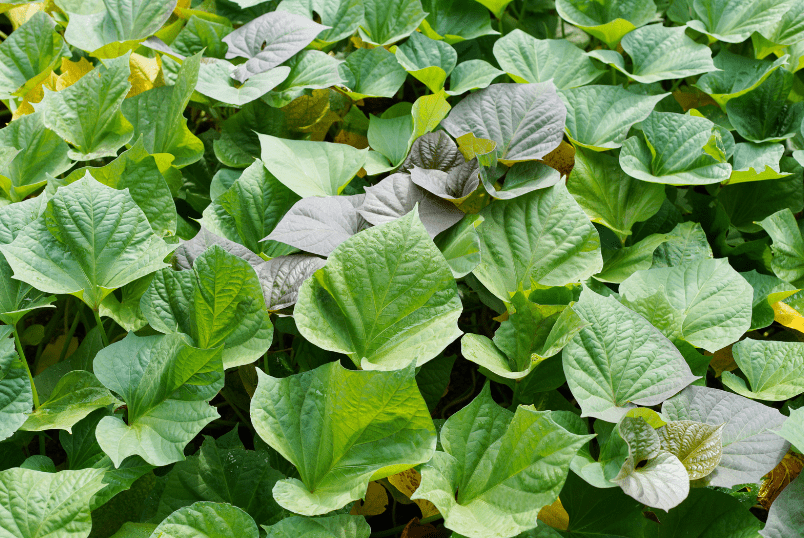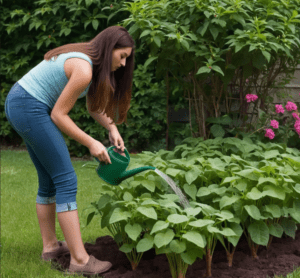
Admire those cascading waves of vibrant foliage in hanging baskets or sprawling landscapes. You’re likely gazing at the beauty of sweet potato vines, also known as potato vine ipomoea batatas. Surprisingly related to the edible kind, these ornamental jewels offer unmatched color and effortless growth for any garden or home décor.
The Allure of Sweet Potato Vines
Their stunning foliage steals the show! From deep purple and striking black to chartreuse and eye-catching variegation, these beauties offer a visual feast. And for something truly unique, explore the ‘Tricolor’ variety, splashed with shades of green, white, and pink. Sweet potato vines also excel as fast-growing additions to vertical gardens or as cascading “spillers” in containers.
Cultivation Tips: How to Grow Sweet Potato Vine
Soil Preparation

- Soil Preparation: Well-draining soil with a pH between 5.5 and 6.5 is key for healthy roots and lush growth.
- Sunlight Requirements: While most varieties bask in full sun for six or more hours daily, some tolerate partial shade.
- Fertilizing: Generally light feeders, but a bit of balanced, slow-release fertilizer at planting boosts them.
- How to Start: Slips or easily-rooted cuttings are the way to go for quick results.
Varieties to Adore
Classic favorites like ‘Blackie’ with its dark, heart-shaped leaves and ‘Margarita’ with vibrant green foliage will delight. For a unique twist, the deeply lobed leaves of ‘Sweet Caroline Sweetheart Red’ will steal your heart.
Sweet Potato Vine Care
Watering

These vines prefer consistent moisture, but forgive the occasional dry spell. A good rule of thumb is to water when the top inch of soil feels dry.
Pruning

To encourage bushier growth, don’t shy away from pruning. Cutting back the vines stimulates growth and keeps your plant looking tidy.
Seasonal Considerations
Gardeners in cooler zones might need to treat these tropical natives as annuals or bring them indoors when temperatures drop, while those in warmer climates can enjoy their perennial growth.
Propagation Techniques
Propagating sweet potato vines through cuttings or tubers is straightforward. For cuttings, snip, place in water, and watch roots develop. Tubers can be saved yearly, offering a cost-effective way to keep your garden lush and extend sweet potato vine growth.
Flowering: A Rare Delight
Though it’s all about the leaves with sweet potato vines, they can flower under certain conditions, like being pot-bound or under light stress. The blooms are a rare treat, adding a layer of beauty to this already stunning plant.
Overwintering Strategies
Overwintering indoors or saving tubers for the next season ensures your sweet potato vines can thrive year after year in cooler climates. The key is a cool, dark place where the tubers won’t freeze or rot.
Pest and Disease Management
Watch for familiar foes like sweet potato weevils or fungal diseases. Organic solutions, such as neem oil for pests and proper air circulation for disease prevention, are practical first steps.
Usual Problems With Sweet Potato Vines
1. Yellowing or Browning Leaves
-
Causes:
- Overwatering or Root Rot: Consistently soggy soil deprives roots of oxygen, leading to decay and yellowing leaves.
- Underwatering: Insufficient moisture causes leaves to turn brown and crispy.
- Fungal diseases: Fungal diseases like leaf spot or blight can cause yellowing or browning, sometimes with spots or lesions.
-
Solutions
- Adjust watering: Ensure the soil is well-draining and only water when the top inch feels dry.
- Check for drainage: If planted in a pot, make sure there are drainage holes.
- Treat fungal diseases: Use an appropriate fungicide if the issue is identified as fungal.
2. Pest Infestations
-
Common culprits:
- Aphids: Tiny sap-sucking insects that cause stunted growth and distorted leaves.
- Sweetpotato weevils: Their larvae feed on the roots and tubers, causing wilting and plant death.
- Golden tortoise beetles: Leave holes in the leaves and are particularly attracted to those with chartreuse foliage. Caterpillars and whiteflies can also cause issues.
-
Solutions:
- Introduce beneficial insects: Ladybugs and lacewings are natural predators of aphids.
- Insecticidal soap or neem oil: Effective against light infestations.
- Systemic insecticides: For serious weevil infestations, but use these with caution.
3. Lack of Vigor or Leggy Growth
-
Causes:
- Insufficient sunlight: Sweet potato vines thrive in full sun, and inadequate light leads to leggy, weak growth.
- Overfertilization: Too much fertilizer can encourage excessive foliage growth while sacrificing root health and overall strength.
-
Solutions:
- Ensure adequate light. Aim for at least 6 hours of direct sun.
- Pruning: Regular pruning encourages bushier growth and can make the plant more compact.
- Adjust fertilization: If you suspect overfeeding, ease off on fertilization.
4. Failure to Flower
-
Causes:
- Sweet potato vines are grown for foliage, and flowering is uncommon, especially in ideal conditions.
- Stress: Factors like being pot-bound or light stress can sometimes trigger blooming.
-
Solutions:
- Enjoy the foliage: This is what these plants do best! If you want flowering vines, consider morning glories (a close relative).
Important Prevention Tips
- Choose healthy plants: Start with disease-free and pest-free plants.
- Proper spacing: Good air circulation helps prevent fungal issues.
- Inspect regularly: Catch pest problems early for easier control.
Conclusion
Growing sweet potato vines is a rewarding venture that instantly appeals to any garden or home. Their easy care and striking beauty make them a perfect choice for seasoned gardeners and those just starting ornamental sweet potato vines.
So why not dive in and try growing a variety you’ve never tried before? The results might surprise you.


























